| Last Modified: 07-31-2024 | 6.11:8.1.0 | Doc ID: RM100000001HS7R |
| Model Year Start: 2020 | Model: Corolla | Prod Date Range: [03/2019 - 09/2022] |
| Title: 2ZR-FAE (FUEL): FUEL SYSTEM: PRECAUTION; 2020 - 2022 MY Corolla [03/2019 - 09/2022] | ||
PRECAUTION
CAUTION:
-
Never perform work on fuel system components near any possible ignition sources.

- Vaporized fuel could ignite, resulting in a serious accident.
-
Do not perform work on fuel system components without first disconnecting the cable from the negative (-) battery terminal.

- Sparks could cause vaporized fuel to ignite, resulting in a serious accident.
-
The fuel tank assembly is very heavy. Be sure to follow the procedure described in the repair manual, or the fuel tank assembly may fall off the engine lifter.
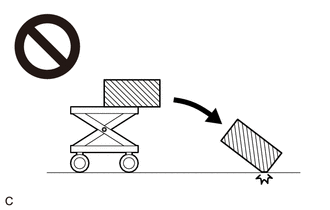
IGNITION SWITCH EXPRESSIONS
(a) The type of ignition switch used on this model differs depending on the specifications of the vehicle. The expressions listed in the table below are used in this section.
|
Expression |
Ignition Switch (Position) |
Engine Switch (Condition) |
|---|---|---|
|
Ignition Switch off |
LOCK |
Off (Lock) |
|
Ignition Switch ACC |
ACC |
On (ACC) |
|
Ignition Switch ON |
ON |
On (IG) |
|
Engine Start |
START |
On (Start) |
BEFORE WORKING ON FUEL SYSTEM
(a) Before inspecting and repairing the fuel system, disconnect the cable from the negative (-) battery terminal.
NOTICE:
After turning the ignition switch off, waiting time may be required before disconnecting the cable from the negative (-) battery terminal. Therefore, make sure to read the disconnecting the cable from the negative (-) battery terminal notices before proceeding with work.
(b) Do not smoke or work near fire when handling the fuel system.
(c) Keep fuel away from rubber or leather parts.
DISCHARGE FUEL SYSTEM PRESSURE
CAUTION:
- Make sure the engine coolant temperature is 60°C (140°F) or less when performing this procedure.
- Do not disconnect any part of the fuel system until you have discharged the fuel system pressure.
- Pressure will still remain in the fuel lines even after performing the following procedure. When disconnecting a fuel line, cover it with a piece of cloth to prevent fuel from spraying or coming out.
(a) When discharging fuel system pressure by disconnecting the C/OPN relay:
(1) Remove the No. 1 relay block cover.
(2) Remove the C/OPN relay.
(3) Start the engine. After the engine has stopped on its own, turn the ignition switch off.
NOTICE:
Do not increase the engine speed or drive the vehicle while waiting for the engine to stop on its own.
(4) Crank the engine again and make sure that the engine does not start.
HINT:
DTC P0171 (System Too Lean (Bank 1)), P1603 (Engine Stall History), P1604 (Startability Malfunction) or P1605 (Rough Idling) may be stored. Clear the DTCs before proceeding to the next step.
(5) Disconnect the cable from the negative (-) battery terminal.
NOTICE:
When disconnecting the cable, some systems need to be initialized after the cable is reconnected.
(6) Remove the fuel tank cap assembly and discharge the pressure from the fuel tank assembly.
(7) Install the C/OPN relay.
(8) Install the No. 1 relay block cover.
(b) When discharging fuel system pressure by disconnecting the fuel suction tube with pump and gauge assembly connector:
(1) Remove the rear floor service hole cover.
(2) Disconnect the fuel suction tube with pump and gauge assembly connector.
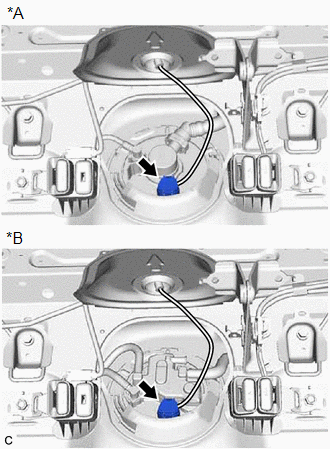
|
*A |
w/ Canister Pump Module |
|
*B |
w/o Canister Pump Module |
(3) Start the engine. After the engine has stopped on its own, turn the ignition switch off.
NOTICE:
Do not increase the engine speed or drive the vehicle while waiting for the engine to stop on its own.
(4) Crank the engine again and make sure that the engine does not start.
HINT:
DTC P0171 (System Too Lean (Bank 1)), P1603 (Engine Stall History), P1604 (Startability Malfunction) or P1605 (Rough Idling) may be stored. Clear the DTCs before proceeding to the next step.
(5) Disconnect the cable from the negative (-) battery terminal.
NOTICE:
When disconnecting the cable, some systems need to be initialized after the cable is reconnected.
(6) Remove the fuel tank cap assembly and discharge the pressure from the fuel tank assembly.
(7) Connect the fuel suction tube with pump and gauge assembly connector.
(8) Install the rear floor service hole cover.
FUEL LINE
(a) When disconnecting a high-pressure fuel line, a large amount of fuel will spray. Perform the following procedure:
(1) Discharge fuel system pressure.
(2) Disconnect the fuel tube.
(3) Drain the fuel remaining inside the fuel tube into a container.
(4) Cover the disconnected fuel pipe and fuel tube connector with plastic bags to prevent damage and contamination.
(b) Quick Type A:
Perform the following procedure when disconnecting a fuel tube connector.
NOTICE:
Remove any foreign matter on the fuel tube connector and fuel pipe before performing this work.
(1) Open the cover of the No. 1 fuel pipe clamp and remove the No. 1 fuel pipe clamp from the fuel tube connector.


|
Open |

|
Pull |
(2) Check that there is no foreign matter around the fuel tube connector before disconnecting it. Clean it if necessary.
(3) Pinch the retainer of the fuel tube connector, and then pull the fuel tube connector off of the fuel pipe.

|
*a |
Retainer |
|
*b |
Fuel Pipe |
|
*c |
Fuel Tube Connector |
|
*d |
O-ring |
|
*e |
Nylon Tube |

|
Pinch |

|
Pull off |
NOTICE:
Be sure to disconnect the fuel tube connector by hand.
(4) If the fuel tube connector and fuel pipe are stuck, push and pull the fuel tube connector to release it. Pull the fuel tube connector off of the fuel pipe carefully.
NOTICE:
- Be sure to disconnect the fuel tube connector by hand.
- Do not scratch or allow any foreign matter to get on the parts when disconnecting them as the fuel tube connector has O-rings that seal the pipe (fuel pipe).
- Do not bend, twist, pinch or kink the nylon tube.
(5) Check that there is no foreign matter on the sealing surfaces of the disconnected fuel lines. Clean them if necessary.
(6) Cover the disconnected fuel pipe and fuel tube connector with plastic bags to prevent damage and contamination.
(c) Quick Type A:
Perform the following procedure when connecting a fuel tube connector.
NOTICE:
Check that there is no damage or foreign matter on the connecting parts of the fuel lines.
(1) Align the fuel tube connector with the fuel pipe, and push them together until the fuel tube connector makes a "click" sound. If it is difficult to push the fuel pipe into the fuel tube connector, apply a small amount of clean gasoline to the tip of the fuel pipe and reinsert it.


|
Push |
(2) After connecting the fuel lines, check that the fuel pipe and fuel tube connector are securely connected by pulling on them.
(3) Install the No. 1 fuel pipe clamp to the fuel tube connector and close the cover of the No. 1 fuel pipe clamp.
(4) Inspect for fuel leaks.
(d) Quick Type B:
Perform the following procedure when disconnecting a fuel tube connector.
NOTICE:
Remove any foreign matter on the fuel tube connector and fuel pipe before performing this work.
(1) Disengage the 2 claws of the retainer. Pull out the retainer and disconnect the fuel tube connector from the fuel pipe.
NOTICE:
Be sure to disconnect the fuel tube connector by hand.

|
*a |
Retainer |
|
*b |
Fuel Pipe |
|
*c |
Fuel Tube Connector |
|
*d |
O-ring |
|
*e |
Claw |
|
*f |
Nylon Tube |

|
Push |

|
Pull out |

|
Pull off |
(2) If the fuel tube connector and fuel pipe are stuck, push and pull the fuel tube connector to release it. Pull the fuel tube connector off of the fuel pipe carefully.
NOTICE:
- Be sure to disconnect the fuel tube connector by hand.
- Do not scratch or allow any foreign matter to get on the parts when disconnecting them as the fuel tube connector has O-rings that seal the pipe (fuel pipe).
- Do not bend, twist, pinch or kink the nylon tube.
(3) Check that there is no foreign matter on the sealing surfaces of the disconnected fuel lines. Clean them if necessary.
(4) Cover the disconnected fuel pipe and fuel tube connector with plastic bags to prevent damage and contamination.
(e) Quick Type B:
Perform the following procedure when connecting a fuel tube connector.
NOTICE:
Check that there is no damage or foreign matter on the connecting parts of the fuel lines.
(1) Align the fuel tube connector with the fuel pipe, push the fuel tube connector onto the fuel pipe, then push in the retainer to engage the 2 claws.
NOTICE:
Confirm that the retainer makes a "click" sound when pushed.
HINT:
If it is difficult to push the fuel tube connector onto the fuel pipe, apply a small amount of clean gasoline to the tip of the fuel pipe.

|
*a |
Retainer |
|
*b |
Claw |

|
Push |

|
Push in |
(2) After connecting the fuel lines, check that the fuel pipe and fuel tube connector are securely connected by pulling on them.
(3) Inspect for fuel leaks.
(f) Quick Type C:
Perform the following procedure when disconnecting a fuel tube connector.
NOTICE:
Remove any foreign matter on the fuel tube connector and fuel pipe before performing this work.
(1) Disengage the 2 claws of the retainer. Pull out the retainer and disconnect the fuel tube connector from the fuel pipe.

|
*a |
Retainer |
|
*b |
Fuel Pipe |
|
*c |
Fuel Tube Connector |
|
*d |
O-ring |
|
*e |
Claw |

|
Push |

|
Pull out |

|
Pull off |
NOTICE:
Be sure to disconnect the fuel tube connector by hand.
(2) If the fuel tube connector and fuel pipe are stuck, push and pull the fuel tube connector to release it. Pull the fuel tube connector off of the fuel pipe carefully.
NOTICE:
- Be sure to disconnect the fuel tube connector by hand.
- Do not scratch or allow any foreign matter to get on the parts when disconnecting them as the fuel tube connector has an O-ring that seals the pipe (fuel pipe).
(3) Check that there is no foreign matter on the sealing surfaces of the disconnected fuel lines. Clean them if necessary.
(4) Cover the disconnected fuel pipe and fuel tube connector with plastic bags to prevent damage and contamination.
(g) Quick Type C:
Perform the following procedure when connecting a fuel tube connector.
NOTICE:
Check that there is no damage or foreign matter on the connecting parts of the fuel lines.
(1) Align the fuel tube connector with the fuel pipe, push the fuel tube connector onto the fuel pipe, then push in the retainer to engage the 2 claws.

|
*a |
Retainer |
|
*b |
Claw |

|
Push |

|
Push in |
NOTICE:
Confirm that the retainer makes a "click" sound when pushed.
HINT:
If it is difficult to push the fuel tube connector onto the fuel pipe, apply a small amount of clean gasoline to the tip of the fuel pipe.
(2) After connecting the fuel lines, check that the fuel pipe and fuel tube connector are securely connected by pulling on them.
(3) Inspect for fuel leaks.
(h) Quick Type D:
Perform the following procedure when disconnecting a fuel tube connector.
NOTICE:
Remove any foreign matter on the fuel tube connector and fuel pipe before performing this work.
(1) Pull out the retainer to disengage the lock claws and pull off the fuel tube connector.
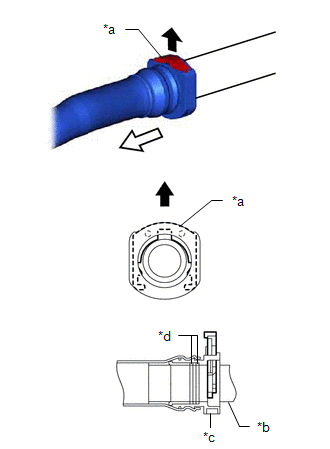
|
*a |
Retainer |
|
*b |
Fuel Pipe |
|
*c |
Fuel Tube Connector |
|
*d |
O-ring |

|
Pull out |

|
Pull off |
(2) If the fuel tube connector and fuel pipe are stuck, push and pull the fuel tube connector to release it. Pull the fuel tube connector off of the fuel pipe carefully.
NOTICE:
Do not scratch or allow any foreign matter to get on the parts when disconnecting them as the fuel tube connector has O-rings that seal the pipe (fuel pipe).
(3) Check that there is no foreign matter on the sealing surfaces of the disconnected fuel lines. Clean them if necessary.
(4) Cover the disconnected fuel pipe and fuel tube connector with plastic bags to prevent damage and contamination.
(i) Quick Type D:
Perform the following procedure when connecting a fuel tube connector.
NOTICE:
Check that there is no damage or foreign matter on the connecting parts of the fuel lines.
(1) Align the fuel tube connector with the fuel pipe, push the fuel tube connector onto the fuel pipe, then push in the retainer to secure the connection.

|
*a |
Retainer |

|
Push |

|
Push in |
NOTICE:
Confirm that the retainer makes a "click" sound when pushed.
HINT:
If it is difficult to push the fuel tube connector onto the fuel pipe, apply a small amount of clean gasoline to the tip of the fuel pipe.
(2) After connecting the fuel lines, check that the fuel pipe and fuel tube connector are securely connected by pulling on them.
(3) Inspect for fuel leaks.
(j) Quick Type E:
Perform the following procedure when disconnecting a fuel tube connector.
NOTICE:
Remove any foreign matter on the fuel tube connector and fuel pipe before performing this work.
(1) Pull out the retainer to disengage the lock claws and pull off the fuel tube connector.
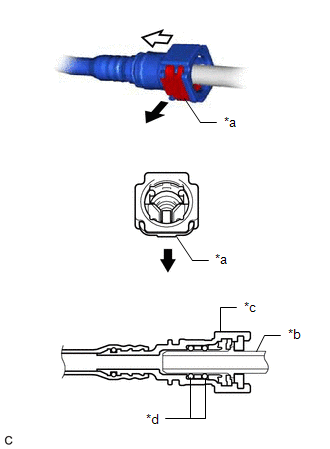
|
*a |
Retainer |
|
*b |
Fuel Pipe |
|
*c |
Fuel Tube Connector |
|
*d |
O-ring |

|
Pull out |

|
Pull off |
(2) If the fuel tube connector and fuel pipe are stuck, push and pull the fuel tube connector to release it. Pull the fuel tube connector off of the fuel pipe carefully.
NOTICE:
Do not scratch or allow any foreign matter to get on the parts when disconnecting them as the fuel tube connector has O-rings that seal the pipe (fuel pipe).
(3) Check that there is no foreign matter on the sealing surfaces of the disconnected fuel lines. Clean them if necessary.
(4) Cover the disconnected fuel pipe and fuel tube connector with plastic bags to prevent damage and contamination.
(k) Quick Type E:
Perform the following procedure when connecting a fuel tube connector.
NOTICE:
Check that there is no damage or foreign matter on the connecting parts of the fuel lines.
(1) Align the fuel tube connector with the fuel pipe, push the fuel tube connector onto the fuel pipe, then push in the retainer to secure the connection.

|
*a |
Retainer |

|
Push |

|
Push in |
NOTICE:
Confirm that the retainer makes a "click" sound when pushed.
HINT:
If it is difficult to push the fuel tube connector onto the fuel pipe, apply a small amount of clean gasoline to the tip of the fuel pipe.
(2) After connecting the fuel lines, check that the fuel pipe and fuel tube connector are securely connected by pulling on them.
(3) Inspect for fuel leaks.
(l) Quick Type F:
Perform the following procedure when disconnecting a fuel tube connector.
NOTICE:
Remove any foreign matter on the fuel tube connector and fuel pipe before performing this work.
(1) Pull out the retainer to disengage the lock claws and pull off the fuel tube connector.
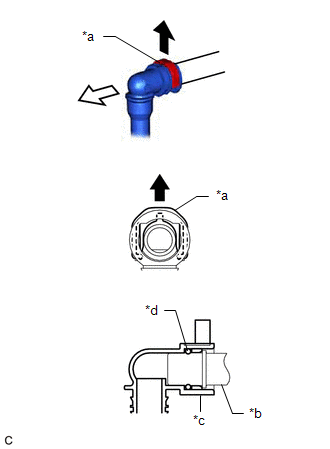
|
*a |
Retainer |
|
*b |
Fuel Pipe |
|
*c |
Fuel Tube Connector |
|
*d |
O-ring |

|
Pull out |

|
Pull off |
(2) If the fuel tube connector and fuel pipe are stuck, push and pull the fuel tube connector to release it. Pull the fuel tube connector off of the fuel pipe carefully.
NOTICE:
Do not scratch or allow any foreign matter to get on the parts when disconnecting them as the fuel tube connector has an O-ring that seals the pipe (fuel pipe).
(3) Check that there is no foreign matter on the sealing surfaces of the disconnected fuel lines. Clean them if necessary.
(4) Cover the disconnected fuel pipe and fuel tube connector with plastic bags to prevent damage and contamination.
(m) Quick Type F:
Perform the following procedure when connecting a fuel tube connector.
NOTICE:
Check that there is no damage or foreign matter on the connecting parts of the fuel lines.
(1) Align the fuel tube connector with the fuel pipe, push the fuel tube connector onto the fuel pipe, then push in the retainer to secure the connection.

|
*a |
Retainer |

|
Push |

|
Push in |
NOTICE:
Confirm that the retainer makes a "click" sound when pushed.
HINT:
If it is difficult to push the fuel tube connector onto the fuel pipe, apply a small amount of clean gasoline to the tip of the fuel pipe.
(2) After connecting the fuel lines, check that the fuel pipe and fuel tube connector are securely connected by pulling on them.
(3) Inspect for fuel leaks.
(n) Quick Type G:
Perform the following procedure when disconnecting a fuel tube connector.
NOTICE:
Remove any foreign matter on the fuel tube connector and fuel pipe before performing this work.
(1) Pull out the retainer to disengage the lock claws and pull off the fuel tube connector.

|
*a |
Retainer |
|
*b |
Fuel Pipe |
|
*c |
Fuel Tube Connector |
|
*d |
O-ring |

|
Pull out |

|
Pull off |
(2) If the fuel tube connector and fuel pipe are stuck, push and pull the fuel tube connector to release it. Pull the fuel tube connector off of the fuel pipe carefully.
NOTICE:
Do not scratch or allow any foreign matter to get on the parts when disconnecting them as the fuel tube connector has an O-ring that seals the pipe (fuel pipe).
(3) Check that there is no foreign matter on the sealing surfaces of the disconnected fuel lines. Clean them if necessary.
(4) Cover the disconnected fuel pipe and fuel tube connector with plastic bags to prevent damage and contamination.
(o) Quick Type G:
Perform the following procedure when connecting a fuel tube connector.
NOTICE:
Check that there is no damage or foreign matter on the connecting parts of the fuel lines.
(1) Align the fuel tube connector with the fuel pipe, push the fuel tube connector onto the fuel pipe, then push in the retainer to secure the connection.

|
*a |
Retainer |

|
Push |

|
Push in |
NOTICE:
Confirm that the retainer makes a "click" sound when pushed.
HINT:
If it is difficult to push the fuel tube connector onto the fuel pipe, apply a small amount of clean gasoline to the tip of the fuel pipe.
(2) After connecting the fuel lines, check that the fuel pipe and fuel tube connector are securely connected by pulling on them.
(3) Inspect for fuel leaks.
(p) Quick Type H:
Perform the following procedure when disconnecting a fuel tube connector.
NOTICE:
Remove any foreign matter on the fuel tube connector and fuel pipe before performing this work.
(1) Pull out the retainer to disengage the lock claws and pull off the fuel tube connector.

|
*a |
Retainer |
|
*b |
Fuel Pipe |
|
*c |
Fuel Tube Connector |
|
*d |
O-ring |

|
Pull out |

|
Pull off |
(2) If the fuel tube connector and fuel pipe are stuck, push and pull the fuel tube connector to release it. Pull the fuel tube connector off of the fuel pipe carefully.
NOTICE:
Do not scratch or allow any foreign matter to get on the parts when disconnecting them as the fuel tube connector has O-rings that seal the pipe (fuel pipe).
(3) Check that there is no foreign matter on the sealing surfaces of the disconnected fuel lines. Clean them if necessary.
(4) Cover the disconnected fuel pipe and fuel tube connector with plastic bags to prevent damage and contamination.
(q) Quick Type H:
Perform the following procedure when connecting a fuel tube connector.
NOTICE:
Check that there is no damage or foreign matter on the connecting parts of the fuel lines.
(1) Align the fuel tube connector with the fuel pipe, push the fuel tube connector onto the fuel pipe, then push in the retainer to secure the connection.
NOTICE:
Confirm that the retainer makes a "click" sound when pushed.
HINT:
If it is difficult to push the fuel tube connector onto the fuel pipe, apply a small amount of clean gasoline to the tip of the fuel pipe.

|
*a |
Retainer |

|
Push |

|
Push in |
(2) After connecting the fuel lines, check that the fuel pipe and fuel tube connector are securely connected by pulling on them.
(3) Inspect for fuel leaks.
(r) Quick Type I:
Perform the following procedure when disconnecting a fuel tube connector.
NOTICE:
Remove any foreign matter on the fuel tube connector and fuel pipe before performing this work.
(1) Disengage the 2 claws of the retainer. Pull out the retainer and disconnect the fuel tube connector from the fuel pipe.

|
*a |
Retainer |
|
*b |
Fuel Pipe |
|
*c |
Fuel Tube Connector |
|
*d |
O-ring |
|
*e |
Claw |

|
Push |

|
Pull out |

|
Pull off |
NOTICE:
Be sure to disconnect the fuel tube connector by hand.
(2) If the fuel tube connector and fuel pipe are stuck, push and pull the fuel tube connector to release it. Pull the fuel tube connector off of the fuel pipe carefully.
NOTICE:
- Be sure to disconnect the fuel tube connector by hand.
- Do not scratch or allow any foreign matter to get on the parts when disconnecting them as the fuel tube connector has an O-ring that seals the pipe (fuel pipe).
(3) Check that there is no foreign matter on the sealing surfaces of the disconnected fuel lines. Clean them if necessary.
(4) Cover the disconnected fuel pipe and fuel tube connector with plastic bags to prevent damage and contamination.
(s) Quick Type I:
Perform the following procedure when connecting a fuel tube connector.
NOTICE:
Check that there is no damage or foreign matter on the connecting parts of the fuel lines.
(1) Align the fuel tube connector with the fuel pipe, push the fuel tube connector onto the fuel pipe, then push in the retainer to engage the 2 claws.
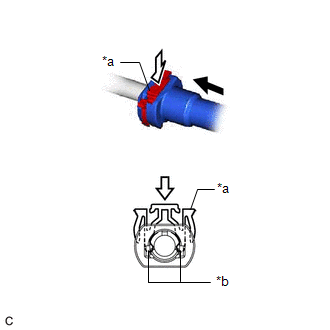
|
*a |
Retainer |
|
*b |
Claw |

|
Push |

|
Push in |
NOTICE:
Confirm that the retainer makes a "click" sound when pushed.
HINT:
If it is difficult to push the fuel tube connector onto the fuel pipe, apply a small amount of clean gasoline to the tip of the fuel pipe.
(2) After connecting the fuel lines, check that the fuel pipe and fuel tube connector are securely connected by pulling on them.
(3) Inspect for fuel leaks.
(t) Metallic Type:
Perform the following procedure when disconnecting a fuel tube connector.
NOTICE:
Remove any foreign matter on the fuel tube connector and fuel pipe before performing this work.
(1) Remove the No. 2 fuel pipe clamp.

|
*A |
for TMC Made |
|
*B |
for TMMMS Made |
NOTICE:
Do not reuse the No. 2 fuel pipe clamp.
(2) Install SST (fuel hose puller) to the fuel tube connector as shown in the illustration.
SST: 09268-21011

(3) Turn SST (fuel hose puller), align the retainers inside the fuel tube connector with the SST (fuel hose puller) chamfers and insert SST (fuel hose puller) into the fuel tube connector.

|
*a |
Retainer (4 places) |
(4) Mount the retainer of the fuel tube connector onto the chamfered part of SST (fuel hose puller).
(5) Slide SST (fuel hose puller) and the fuel tube connector together until they make a "click" sound, and then disconnect the fuel tube sub-assembly.
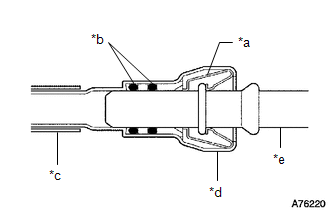
|
*a |
Retainer |
|
*b |
O-ring |
|
*c |
Nylon Tube |
|
*d |
Fuel Tube Connector |
|
*e |
Fuel Pipe |
NOTICE:
- Do not scratch or allow any foreign matter to get on the parts when disconnecting them as the fuel tube connector has O-rings that seal the pipe (fuel pipe).
- Do not bend, twist, pinch or kink the nylon tube.
(6) Check that there is no foreign matter on the sealing surfaces of the disconnected fuel lines. Clean them if necessary.
(7) Cover the disconnected fuel pipe and fuel tube connector with plastic bags to prevent damage and contamination.
(u) Metallic Type:
Perform the following procedure when connecting a fuel tube connector.
NOTICE:
Check that there is no damage or foreign matter on the connecting parts of the fuel lines.
(1) Align the fuel tube connector with the fuel pipe, and push them together until the fuel tube connector makes a "click" sound. If it is difficult to push the fuel pipe into the fuel tube connector, apply a small amount of clean gasoline to the tip of the fuel pipe and reinsert it.


|
Pull |
(2) After connecting the fuel lines, check that the fuel pipe and fuel tube connector are securely connected by pulling on them.
(3) Install a new No. 2 fuel pipe clamp.
(4) Inspect for fuel leaks.
FUEL INJECTOR ASSEMBLY
(a) Observe the following precautions when removing and installing the fuel injector assemblies:

|
*1 |
O-ring |
|
*2 |
Fuel Delivery Pipe Sub-assembly |
|
*a |
Correct |
|
*b |
Incorrect |
(1) Do not reuse the O-ring.
(2) When installing a new O-ring to the fuel injector assembly, do not damage the O-ring.
(3) Apply gasoline or spindle oil to a new O-ring before installing it.
NOTICE:
Do not use engine oil, gear oil or brake fluid.
(b) Install the fuel injector assembly to the cylinder head sub-assembly as shown in the illustration.
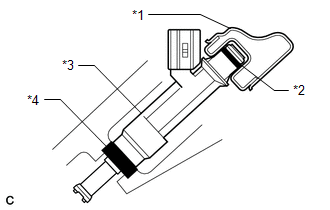
|
*1 |
Fuel Delivery Pipe Sub-assembly |
|
*2 |
O-ring |
|
*3 |
Fuel Injector Assembly |
|
*4 |
Injector Vibration Insulator |
(1) Do not reuse the injector vibration insulator.
FUEL SUCTION TUBE WITH PUMP AND GAUGE ASSEMBLY
NOTICE:
Do not disconnect the tube shown in the illustration when disassembling the fuel suction tube with pump and gauge assembly. Doing so will cause reassembly of the fuel suction tube with pump and gauge assembly to be impossible as the tube is pressed into the fuel suction plate sub-assembly.
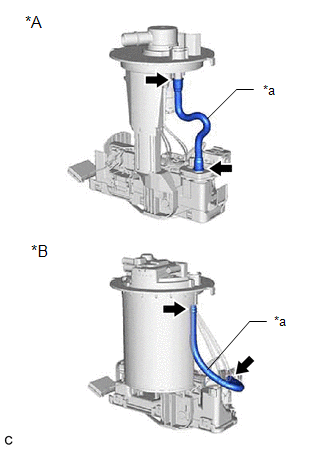
|
*A |
w/ Canister Pump Module |
|
*B |
w/o Canister Pump Module |
|
*a |
Tube |
INSPECT FOR FUEL LEAK
(a) Check that there are no fuel leaks from the fuel system after doing any maintenance or repairs.
|
|
|
![2020 MY Corolla Corolla Hatchback Corolla HV GR Corolla [03/2019 - 09/2019]; INTRODUCTION: REPAIR INSTRUCTION: INITIALIZATION](/t3Portal/stylegraphics/info.gif)